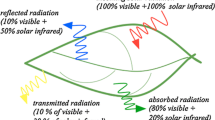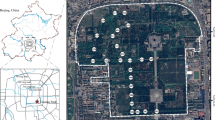Abstract
Trees in cities have an important positive effect on people’s lives. One such positive effect is the amelioration of microclimate. The aim of this research is to assess the correlation between parameters that affect the microclimate of parks during the summer. We measured air temperature, relative humidity and solar radiation in the sun and shade of the trees in urban parks in Thessaloniki, Greece. The results indicate that: the air (A) temperature reduction percentage (dTair%), air relative humidity increase (dTRh%), discontent index reduction percentage (DI%) (cooling effect) and solar radiation (L) percentage that passes through the trees’ foliage to their shade creates an exponential function of dA% = a.e-bL. These functions are also applicable to the limiting variation values of the parameters. If we use L = 0 (meaning Lightsh = 0, which is the case for an extremely dense tree), then the values that we expect from this particular parameter are the maximum possible. These maximum values are a characteristic feature of the parameter variation for this particular research area. These maximum values for the trees in the parks of Thessaloniki are: maxdTair% ≈ 24%, maxdRh% ≈ 41% and maxdDI% ≈16%.
Similar content being viewed by others
References
Akbari H, Davis S, Dorsano S, Huang J, Winnett S (1992) Cooling our communities: A guidebook to tree planting and light colored surfacing. U.S. E.P.A., Office of Policy Analysis, Climate Change Division Report. Washington, D.C., 22P-2001, pp 217
Akbari H, Taha H (1992) The impact of trees and white surfaces on residential heating and cooling energy use in four Canadian cities. Energy 17(2):141–149
Akbari H, Pomerantz M, Taha H (2001) Cool surface and shade trees to reduce energy use and improve air quality in urban areas. Solar Energy 70(3):259–310
Balafoutis CH, Arseni—Papadimitriou A, Chantzaridis P (1998) Distribution of Thermal Comfort during June at Greek land In Proceedings: 4 th Panellenic Geographical Conference at 12, 13, 14 October 1995., Greek Geographical Union, pp 440–450
Balafoutis CH, Maheras P (1986) Geographical Distribution and Grouping of Bioclimatic Types in Greece related to Air Enthalpy'. Zeitschrift Fur Meteorological, 36(4):259–264
Dafis S (2001) Urban Forestry, ART of TEXT ISBN: 960-312-080-4, Thessaloniki, Greece, pp198 (in Greek)
Dimoudi A, Nikolopoulou M (2003) Vegetation in urban environment: microclimatic analysis and benifits. Energy and Buildings 35:69–76
Ferrante A, Mihalakakou G (2001) The influence of water, green and selected passive techniques on the rehabitation of historical industrial buildings in urban areas. Solar Energy 70(3):245–253
Foster R (1978) Homeowner's Guide to Landscaping that saves energy dollars. David Mckay, New York. pp 183
Giles B, Balafoutis CH, Arseni A (1987) A study of climatic stress and Physiological regimes in Greece. Journal of Climatology 7:303–313
Givoni B, Noguchi M, Saaroni H, Pochter O, Yaacov Y, Feller N, Becker S (2003) Outdoor comfort research issues. Energy and Buildings 35:77–86
Heilman J, Brittin C, Zajicek J (1989) Water use by shrubs as affected by energy exchange with building walls. Agriculture and Forestry Meteorology 48:345–357
Heisler GM (1982) Reduction of solar radiation by tree crowns. The renewable Challenge. In: Proceedings: 1982 Annual Meeting of the American Section of International Solar Energy Society, Houston. TX. American Solar Energy Society Boulder, CO. pp 133–139
Heisler GM (1984) Planting design for wind control, chapter nine. In: Energy-Conserving Site Design. American Society of Landscape Architects (Eds E.G. McPherson). Washington, DC, pp 165–183
Heisler GM (1985) Measurements of solar radiation on vertical surfaces in the shade of individual trees. In: Proceedings of Forest Environmental Measurements Conference. October 23–28 1983, Oak Ridge, TN. Reidel Publishing Co., Dordrecht, Holland, pp 319–335
Heisler GM (1990) Mean wind speed below building height in residential neighborhoods with different tree density'. ASHRAE. Translation 96:1389–1396
Herrington LP, Bertolin G E, Leonard, RE (1972) Microclimate of a suburban park. In: Proceedings of a Conference on the Urban Environment, American Meteorological Society, Boston, pp 43–44
Herrington LP, Plumley H (1976) The Design of Outdoor Urban Spaces for Human Comfort. Final Report Grant, FSNE-21, North-eastern Forest Exp. Stat., U.S.F.S., Upper Darly Pa. pp 204
Herrington LP (1978) Vegetation and Thermal Environments of Human Settlements. Environments of Human Settlements. In: Proceedings of the Conference: Trees and Forest for Human Settlements. pp. 372–379, Centre for Urban Forestry Studies, University of Toronto
Kjelgren RK, Clark JR (1992) Microclimate and Tree Growth in Tree Urban Spaces'. Journal of Environmental Horticulture 10(3):139–145
McGinn C (1982) Microclimate and energy use in suburban tree canopies. Ph.D. Thesis, University of California at Davis
Oke TR (1974) Review of Urban Climatology. WMO. Tech. Note No 134. Geneva. pp 132
Parker JH (1983) Landscaping to reduce the energy used in cooling buildings. Journal of Forestry, 81(2):82–104
Parker JR (1989) The impact of vegetation on air conditioning consumption. Controlling summer heat island'. In: Akbari H, Garbesi K, Martien P (eds.) Proceedings of the workshop on: Saving energy and reducing atmospheric pollution by controlling summer heat island, University of California, Barkley, California, pp 42–52
Plumley HJ (1975) The design of outdoor urban spaces for thermal comfort. In: Proceedings of a Conference: Metropolitan physical environment(USDA Forest Service general technical Report NE-25), Upper Darly, Pennsylvania, US Department of Agriculture Forest Service, pp 15252–15262
Rowntree AR (1986) Ecology of the Urban Forest-Introduction to Part II. Urban Ecology 9:229–243
Shashua-Bar L, Hoffman ME (2003) Geometry and orientation aspects in passive cooling of canyon streets with trees. Energy and Buildings 35:61–68
Shobhakar D, Hanaki K (2002) Improvement of urban thermal environment by managing heat discharge sources and surface modification in Tokyo. Energy and Building 34:13–23
Souch CA, Souch C (1993) The effect of trees on summertime below canopy urban climates: a case study Bloomington, Indiana. Journal of Arboriculture 19(5):303–312
Taha HG, Akbari H, Rosenfeld AH (1988) Vegetation canopy micro-climate: a field project in Davis, California. Lawrence Berkley in Davis, Laboratory Report-24593, Berkley, CA
Thayer RL, Maeda BT (1985) Measuring street tree impact on solar performance: a five-climate computer modeling study. Journal of Arboriculture 11(1):1–12
Thom EC (1959) The distribution index. Weatherize 12(2):57–60
Zajicek J, Heilman J (1991) Transpiration by crape myrtle cultivars surrounded by mulch, soil and turf grass surface. Horticulture Science 26:1207–1210
Author information
Authors and Affiliations
Corresponding author
Rights and permissions
About this article
Cite this article
Georgi, N.J., Zafiriadis, K. The impact of park trees on microclimate in urban areas. Urban Ecosyst 9, 195–209 (2006). https://doi.org/10.1007/s11252-006-8590-9
Published:
Issue Date:
DOI: https://doi.org/10.1007/s11252-006-8590-9




